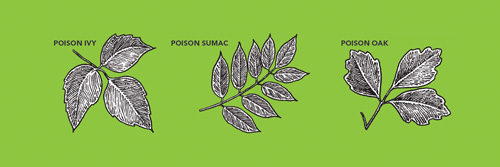Avoid poisonous plants when working outdoors

If you’ve ever come in contact with poison ivy, you know how unpleasant it can be. And for many outdoor workers, poisonous plants are a common hazard. Workers at risk include farmers, foresters, landscapers, groundskeepers, gardeners, painters, roofers, pavers, construction workers, laborers, mechanics “and any other workers who spend time outside,” according to NIOSH.
What’s the problem?
The United States is home to a number of poisonous plants, including poison ivy, poison sumac and poison oak. (Visit www.cdc.gov/niosh/topics/plants/default.html for descriptions and images.) Problems arise when workers come in contact with the sap oil of these plants. NIOSH explains that the oil, called urushiol, is released when the plants are disturbed, bruised, damaged or burned. About 80 to 90 percent of workers who get this oil on their skin will experience an itchy red rash with bumps and blisters. For most people, this rash can be treated by using over-the-counter medication. However, some workers experience more severe reactions that may require medical attention. This often occurs when poisonous plants are burned and workers are exposed by inhaling urushiol, NIOSH states.
NIOSH recommends that employers train their outdoor workers on understanding the risks of exposure to these plants, how to identify poisonous plants, how to prevent exposure and what to do if they’re exposed.
Prevention
Workers can take a number of steps to protect themselves from poisonous plants, NIOSH states. These include:
- Wear long-sleeved shirts, pants and gloves. Wash any exposed clothing separately to prevent contamination of other clothing.
- Consider using barrier creams that contain bentoquatam – a lotion that helps prevent poison oak, poison ivy and poison sumac rashes.
- Clean tools after every use with rubbing alcohol or soap and water. Be sure to wear disposable gloves while doing so, as urushiol can remain active on objects for up to five years.
- Refrain from burning plants if you believe they may be poisonous.
If exposure to poisonous plants occurs, rinse the affected skin immediately with soap and water or poison plant wash, NIOSH states. Be sure to thoroughly scrub under the nails. Apply a wet compress or calamine lotion to the skin, but never on broken skin or weeping blisters. Consider taking an antihistamine to help reduce swelling.
Post a comment to this article
Safety+Health welcomes comments that promote respectful dialogue. Please stay on topic. Comments that contain personal attacks, profanity or abusive language – or those aggressively promoting products or services – will be removed. We reserve the right to determine which comments violate our comment policy. (Anonymous comments are welcome; merely skip the “name” field in the comment box. An email address is required but will not be included with your comment.)

